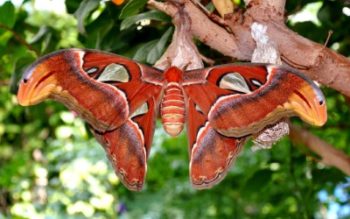
There are many species of moths. They come in many different sizes, colors, and ranges of habitats, so that when you see one you may think nothing of it. One that will definitely catch your eye is the Atlas Moth (Attacus atlas), which is one of the largest species in the world, with a massive wingspan that can reach up to 12 inches! The natural habitat of Atlas moths are the tropical and forest regions of Asia, such as India, Indonesia, and the Philippines. However, they’ve been sighted in the Seattle area recently potentially due to an illegal cocoon-selling operation. Learn more about these enchanting creatures below!
Lifecycle
Atlas moths start out as good-sized caterpillars feeding constantly on their favorite leaves from citrus, guava, cinnamon, and Jamaican cherry trees, gorging on enough food to build up fat reserves to last for its pupa and adult moth stages. Atlas moths spin their silk casing into a cocoon that’s filled with leftover leaves and will emerge after about a month as an enormous atlas moth. Their main purpose is to find a mate and reproduce only living for about one to two weeks from the food supply they gathered during their caterpillar stages because of their lack of ability to eat in their adult lives. With such a short lifespan they stick close to home for mating purposes and mostly travel at night. Their mating process can last up to 24 hours, and before dying the females can lay as many as 150 eggs.
Defense /Appearance
You might think that only butterflies have colorful wings, but the Atlas moth takes it to a whole other level, with their bold dark-orange wings. But wait, they also have a built-in defense mechanism to scare off predators -patterns on their wings that resemble a cobra’s head. When the atlas moth feels threatened, it slowly starts to move its wingtips, using the false eyes on its wings to repel and distract potential attackers. Since their main predators are animals like birds and lizards who are visual hunters, they can confuse the atlas moth with another local animal which is the cobra. The markings on their wings are an adaptation which has been crucial for their survival.
Will I Spot One?
Although not native to our region they have been spotted a long way from their native habitat, in Bellevue, Washington, near Seattle. This caused concern in the U.S. Department of Agriculture because of the ability of larval atlas moths to decimate plants when in caterpillar form. Their presence here in the U.S. is being heavily monitored. Per the U.S Department of Agriculture, it’s illegal to “obtain, harbor, rear or sell live moths, whether adults, eggs, larvae or pupae without a permit” as the atlas moth (Attacus atlas) are federally quarantined pests. If you spot one you should report it to your state plant health director.
Although the atlas moth hasn’t made its way to Virginia yet, we still have plenty of other pests to deal with. The dedicated exterminators at Loyal Termite & Pest Control have been your local pest control company for over 60 years! Whether you own a home or business in the Richmond VA area, it’s important to work with experienced local professionals that can tackle the unique pest problems we face in Eastern & Central VA. Contact us today to get started!
